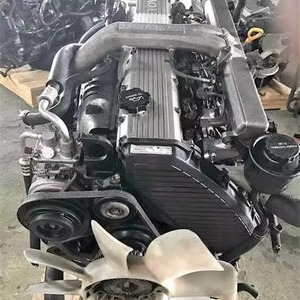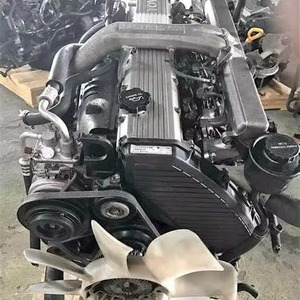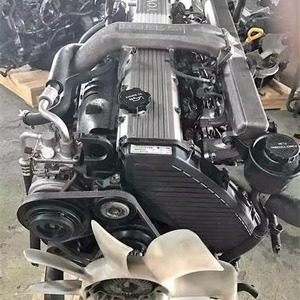Types of Toyota 1HD Engines
The 1HD engine is a six-cylinder in-line, water-cooled, four-stroke cycle diesel engine developed by Toyota for heavy-duty trucks and equipment. With a 4.2-liter displacement, it efficiently moves air and fuel through the cylinders, featuring a bore of 102 mm and stroke of 105 mm. The 1HD engine family includes several variations, each designed to meet specific performance requirements and applications.
1HD-F
The 1HD-F is a turbocharged diesel engine that forces more air into the cylinders for improved combustion. This design generates greater power and efficiency compared to naturally aspirated engines.
Key Feature: Basic turbocharged configuration
Best For: Older Toyota Land Cruiser models requiring reliability and durability in challenging conditions
1HD-T
The 1HD-T enhances the basic turbocharged design by adding an intercooler system. This additional component cools compressed air before it enters the engine, resulting in denser air intake and improved power output and efficiency.
Key Feature: Turbocharged with intercooler
Best For: Off-road applications and rugged terrain where increased power delivery is necessary
1HD-FT
The 1HD-FT represents the most advanced configuration with a turbocharged system, intercooler, and double overhead camshaft (DOHC) design. The DOHC architecture improves valve control and airflow for optimal performance.
Key Feature: DOHC with turbocharger and intercooler
Best For: Newer Land Cruiser models requiring excellent performance, fuel efficiency, and improved emissions control
Engine Evolution Timeline
- 1990-1994: Introduction of the 1HD-F engine in early Toyota Land Cruiser 80 Series
- 1994-1998: Development of 1HD-T with intercooler technology for improved efficiency
- 1998-2007: Introduction of 1HD-FT with DOHC architecture for newer Land Cruiser models
- 2007-Present: Transition to newer engine series with some markets still utilizing 1HD variants
Expert Tip: When identifying a 1HD engine variant, look for the engine code stamped on the block near the cylinder head. The "F" designation indicates fuel injection, "T" indicates turbocharging, and combined letters indicate multiple features (e.g., "FT" for fuel injection with turbocharger).
Specifications and Technical Details
The Toyota 1HD engine series delivers exceptional durability, reliability, and impressive low-end torque for heavy-duty applications. Each variant offers specific performance characteristics to meet different operational needs:
| Specification | 1HD-F | 1HD-T | 1HD-FT | 1HD-FTE |
|---|---|---|---|---|
| Displacement | 4.2L (4210cc) | 4.2L (4210cc) | 4.5L (4461cc) | 4.5L (4461cc) |
| Bore × Stroke | 97.0mm × 102.0mm | 97.0mm × 102.0mm | 96.0mm × 102.0mm | 96.0mm × 102.0mm |
| Power Output | 150hp (112kW) @ 4,000rpm | 155hp (115kW) @ 4,000rpm | 177hp (132kW) @ 3,600rpm | 202hp (150kW) @ 3,600rpm |
| Torque Output | 380Nm @ 2,200rpm | 400Nm @ 2,200rpm | 420Nm @ 2,000rpm | 420Nm @ 2,000rpm |
| Fuel System | Common rail direct injection | Direct fuel injection | Direct fuel injection | Common rail direct injection |
| Valvetrain | DOHC, 24 valves | DOHC, 24 valves | DOHC, 24 valves | DOHC, 24 valves |
| Cooling System | Water cooling | Water cooling | Water cooling | Water cooling |
Performance Note: The 1HD-FTE variant represents the pinnacle of the 1HD series, offering the highest power output and most advanced fuel delivery system. For maximum performance in modern applications, this variant typically provides the best balance of power, efficiency, and reliability.
Essential Maintenance for 1HD Engines
Proper maintenance is crucial for preserving the legendary reliability and longevity of Toyota 1HD engines. These diesel powerplants are known for exceptional durability when properly maintained, often reaching 500,000+ kilometers with proper care.
Regular Oil Changes
1HD engines require consistent oil changes to maintain proper lubrication, reduce friction, and remove contaminants from internal components.
Recommended Interval: Every 5,000km or 6 months
Oil Type: Toyota-recommended diesel engine oil (15W-40 or 10W-30 depending on climate)
Benefits: Reduced wear, improved heat transfer, extended engine life
Cooling System Maintenance
Regular inspection of the cooling system prevents overheating and ensures optimal operating temperatures.
Check Coolant: Monthly inspection of levels and condition
System Flush: Every 40,000km or 4 years
Inspection Points: Hoses, clamps, water pump, radiator, thermostat
Air Filter Service
Clean air intake is critical for diesel engine performance and preventing premature wear.
Inspection: Every 10,000km or 6 months
Cleaning Method: Tap to remove debris or use compressed air (from inside out)
Replacement: When visibly dirty or damaged regardless of mileage
Additional Maintenance Tasks
- Fuel Filter Replacement: Every 20,000km to prevent injector damage and ensure clean fuel delivery
- Timing Belt Inspection: Every 100,000km with replacement at 150,000km
- Injector Service: Every 80,000-100,000km for optimal fuel atomization
- Turbocharger Inspection: Every 50,000km for oil leaks, shaft play, and compressor wheel condition
- Valve Clearance Adjustment: Every 80,000km to maintain proper valve timing and prevent power loss
Warning: Never ignore overheating conditions in 1HD engines. Unlike some engines that can temporarily run hot, continued operation of an overheated diesel can quickly lead to cylinder head warping, blown head gaskets, or cracked blocks - all of which require major repairs.
How to Choose the Right 1HD Engine
Selecting the appropriate 1HD engine variant requires careful consideration of your specific application requirements, performance needs, and budget constraints. Follow this comprehensive selection guide to make an informed decision.
| Selection Factor | Considerations | Recommended Variant |
|---|---|---|
| Power Requirements | Assess your application's power needs (towing, hauling, off-road use) | High power needs: 1HD-FTE (202hp) Medium power: 1HD-FT (177hp) Basic power: 1HD-F (150hp) |
| Fuel Efficiency | Consider operational costs and fuel consumption requirements | Best efficiency: 1HD-FTE with turbocharger and intercooler Good efficiency: 1HD-FT Standard efficiency: 1HD-F |
| Application Type | Match engine characteristics to intended usage pattern | Heavy-duty/towing: 1HD-FT or 1HD-FTE Industrial use: 1HD-T General purpose: 1HD-F |
| Budget Considerations | Balance initial cost with long-term operational expenses | Economy option: 1HD-F (lowest initial cost) Mid-range: 1HD-T Premium: 1HD-FTE (highest cost but best performance) |
Selection Advice: When choosing between 1HD engine variants, consider future needs as well as current requirements. If your application might need more power in the future, investing in a higher-output variant initially can be more cost-effective than upgrading later. Additionally, the improved fuel efficiency of advanced variants like the 1HD-FTE can offset higher initial costs through operational savings.
Application-Specific Recommendations
- Overland Expedition Vehicles: 1HD-FTE for best combination of power and efficiency during long journeys
- Heavy Towing Applications: 1HD-FT for strong low-end torque and reliable power delivery
- Agricultural/Industrial Use: 1HD-T for simplicity and durability in harsh environments
- Urban/Light Duty Use: 1HD-F for cost-effective operation with adequate power
DIY 1HD Engine Replacement Guide
Replacing a 1HD engine is a complex but manageable project for experienced mechanics with proper tools and workspace. This step-by-step guide outlines the essential process, though specific details may vary based on your vehicle model.
Safety Warning: Engine replacement involves heavy components and potentially dangerous systems. Always use proper lifting equipment, jack stands, and safety gear. If you're uncertain about any step, consult a professional mechanic.
Essential Tools and Materials
- Engine hoist/crane (minimum 1-ton capacity)
- Complete socket and wrench sets (metric)
- Torque wrench
- Floor jack and jack stands
- Drain pans for fluids
- New engine mounts, gaskets, and seals
- Fresh coolant, engine oil, and filters
- Service manual specific to your vehicle model
Preparation and Safety Measures
Disconnect the battery negative terminal first, then positive. Ensure the vehicle is securely supported on jack stands if raised. Work in a well-ventilated area with adequate lighting and space around the vehicle.
Drain All Fluids
Properly drain and dispose of engine oil, coolant, power steering fluid, and any other fluids connected to the engine. Use appropriate containers and follow local regulations for fluid disposal.
Remove Peripheral Components
Disconnect and label all electrical connections, hoses, and cables attached to the engine. Remove the radiator, air intake system, exhaust manifold connections, and all drive belts. Document the position of all components for reassembly.
Separate Transmission
Disconnect the transmission from the engine. This typically involves removing the bell housing bolts and supporting the transmission before separating it from the engine.
Remove Engine Mounts
Unbolt the engine mounts while supporting the engine with an engine hoist. Ensure the engine is properly secured to the hoist before completely releasing it from the mounts.
Extract the Engine
Carefully lift the engine using the hoist, ensuring no components remain connected. Move slowly and verify clearance as you extract the engine from the engine bay.
Prepare the New Engine
Transfer necessary components from the old engine to the new one (if not already equipped), such as intake/exhaust manifolds, alternator, power steering pump, and other accessories. Install new gaskets where required.
Install the New Engine
Lower the new engine carefully into position, aligning it with the transmission and engine mounts. Secure the engine mounts and connect the transmission, torquing all bolts to manufacturer specifications.
Reconnect All Components
Reinstall all peripheral components in reverse order of removal. Connect all electrical connectors, hoses, belts, and cables according to your documentation or service manual.
Refill Fluids and Initial Start
Add fresh engine oil, coolant, and other fluids to proper levels. Reconnect the battery, then start the engine and check for leaks, unusual noises, or warning lights. Monitor temperatures and pressures during the initial run period.
Professional Advice: After replacing a 1HD engine, follow a careful break-in procedure for the first 1,000km. Avoid extended idling, maintain varying engine speeds, avoid full throttle operation, and change the oil after the first 1,000km to remove any metal particles from the initial wear-in period.
Frequently Asked Questions About 1HD Engines
The 1HD engine is a six-cylinder in-line diesel engine with a four-stroke cycle design developed by Toyota. It features a cast iron block and aluminum alloy cylinder head with a displacement of 4.2 liters (1HD-F/T) or 4.5 liters (1HD-FT/FTE). With a double overhead camshaft design, it delivers reliable power for heavy-duty applications such as the Land Cruiser series. The engine produces between 150-202 hp depending on the variant, with excellent torque characteristics that make it ideal for tough working conditions.
The 1HD engine series incorporates several advanced features that enhance performance and reliability:
- Turbocharging: Most variants utilize turbochargers to force more air into the combustion chambers, significantly increasing power output
- Intercooler Systems: The T-series variants cool compressed air before it enters the engine, improving density and combustion efficiency
- Variable Valve Timing: Optimizes valve operation based on engine speed and load conditions
- Electronic Fuel Injection: Precise fuel delivery enhances efficiency and reduces emissions
- Dual Overhead Camshafts: Improve throttle response and overall performance through optimized valve actuation
While both engines belong to the same family, they differ in several important aspects:
| Feature | 1HD-F | 1HD-FE |
|---|---|---|
| Fuel System | Mechanical fuel injection | Electronic fuel injection |
| Power Output | Lower (150hp) | Higher (202hp) |
| Displacement | 4.2 liters | 4.5 liters |
| Emissions Control | Basic | Advanced |
| Production Era | Earlier models | Later models |
The 1HD-FE represents an evolution of the earlier 1HD-F design with enhanced efficiency, power, and emissions control technology.
The Toyota 1HD engine series has been installed in several Toyota models, primarily in the Land Cruiser lineup:
- Toyota Land Cruiser 70 Series: Used the 1HD-F, 1HD-T and 1HD-FT variants until 2007
- Toyota Land Cruiser 80 Series: Featured various 1HD engines depending on market and model year
- Toyota Land Cruiser 100 Series: Early models used the 1HD-FTE in certain markets
- Toyota Coaster Bus: Commercial versions utilized 1HD engines in some regions
- Industrial Applications: Modified versions have been used in generators, pumps, and other heavy equipment
After 2007, most Toyota vehicles transitioned to newer engine families, though the 1HD remains popular in commercial and industrial applications in some regions.
Yes, the 1HD engine series has earned a reputation as one of Toyota's most reliable diesel powerplants. When properly maintained, these engines regularly achieve 500,000+ kilometers of service. Their strengths include:
- Robust Block Design: The cast iron construction provides exceptional durability
- Simple Engineering: Earlier variants especially feature straightforward designs with fewer potential failure points
- Excellent Cooling: Effective heat management prevents common diesel engine issues
- Strong Bottom End: Crankshaft and connecting rod design withstands high torque outputs
- Serviceability: Designed with maintenance in mind, allowing for relatively easy access to critical components
The 1HD engine's legendary reliability is a key reason why it remains sought after in the used vehicle market and for engine swaps into other platforms.



































































































































































































































































 浙公网安备 33010002000092号
浙公网安备 33010002000092号 浙B2-20120091-4
浙B2-20120091-4